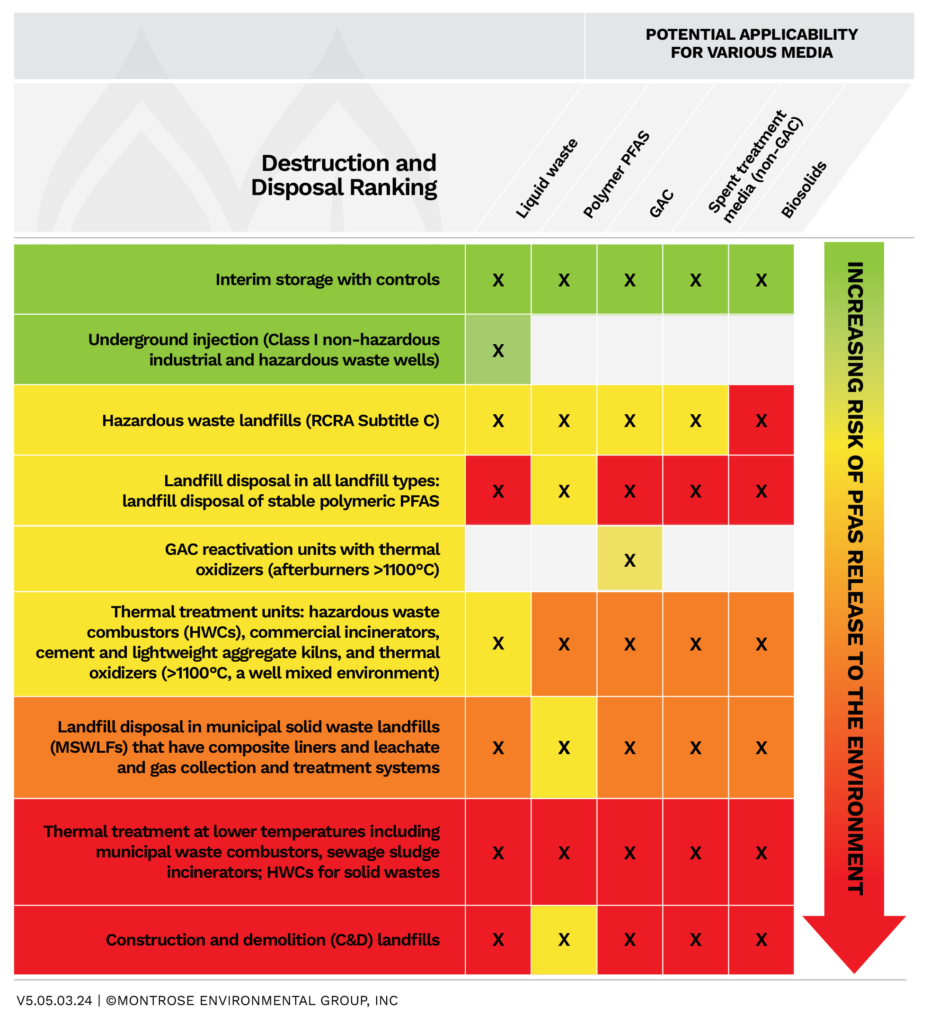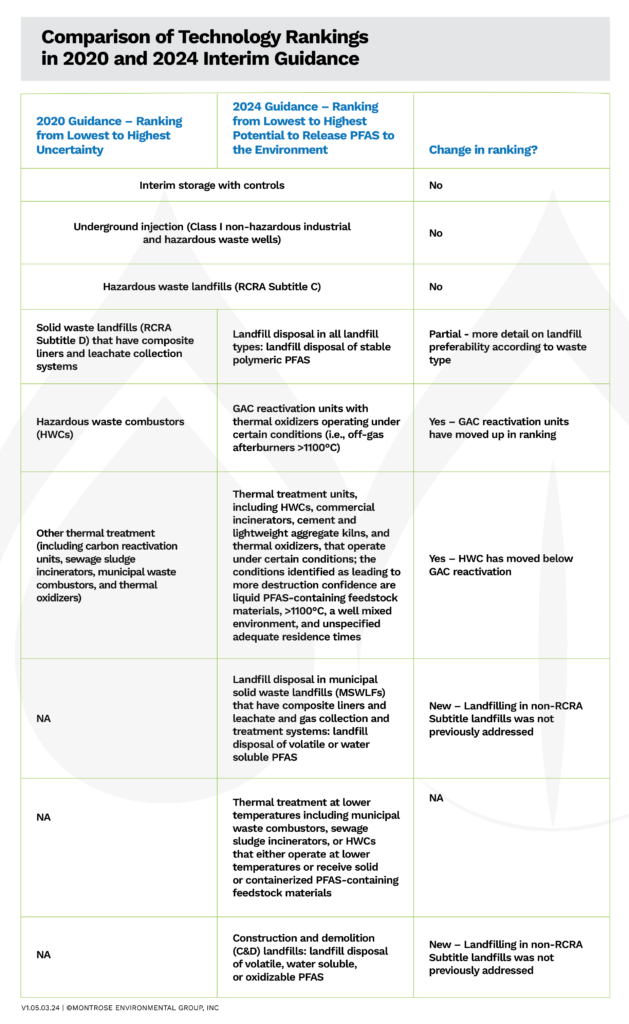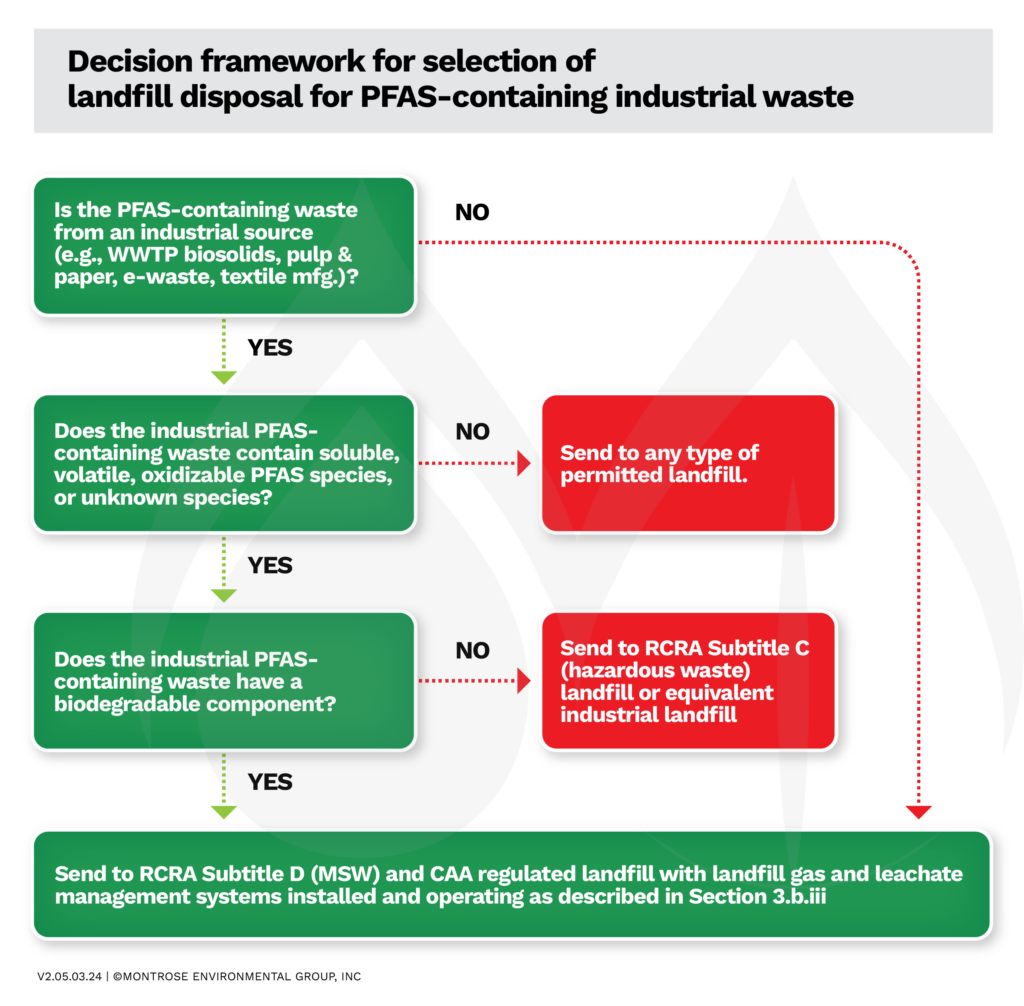
EPA’s Updated Guidance on Destruction and Disposal of PFAS and PFAS Containing Wastes
May 3, 2024
By: Erika Houtz, PhD, PE
On April 8, 2024, the U.S. Environmental Protection Agency (EPA) issued the Interim Guidance on the Destruction and Disposal of Perfluoroalkyl and Polyfluoroalkyl Substances and Materials Containing Perfluoroalkyl and Polyfluoroalkyl Substances, Version 2, which is an update to the initial 2020 version. This Interim Guidance incorporates feedback from the 77 unique public comments provided for the 2020 version.
The revised Interim Guidance focused on the current state of the science and associated uncertainties for three technologies with large-scale capacity that can destroy PFAS or control its release into the environment: thermal destruction, landfills, and underground injection. The guidance is aimed at decisionmakers who need to identify the most effective means for destroying or disposing of PFAS and materials containing PFAS.
Does this guidance dictate how to manage waste?
While disposal and destruction options were ranked in order of increasing risk of PFAS release to the environment (Figure 1), there was no prescriptive guidance on how to dispose of PFAS and PFAS-containing wastes, and there were no guarantees that any particular method would be appropriate. EPA has provided a decision tree for landfill selection of PFAS-containing industrial wastes, if landfilling is elected as the proposed disposal choice (Figure 2). While there was discussion of destruction and removal efficiency (DRE) in the context of thermal destruction, EPA took no position regarding potentially safe levels of residual PFAS or acceptable DREs.
Destruction and disposal of PFAS-containing materials and wastes are not currently federally regulated; they may be managed in non-hazardous and hazardous waste treatment disposal systems. This flexibility would be restricted if PFAS, individually or as a class, become listed under the Resource Conservation and Recovery Act (RCRA).
Some entities, such as the Department of Defense (DoD), have issued guidance on PFAS waste management that is prescriptive for PFAS waste management at DoD facilities.
Figure 1.

What has changed since 2020?
Functionally, very little has changed in how waste-handling options were ranked in the 2020 guidance (Table 1). One difference is that granular activated carbon (GAC) reactivation is now ranked as having a lower potential to release PFAS to the environment than hazardous waste combustion, but GAC reactivation is still ranked below interim storage and landfilling in RCRA Subtitle C and D landfills.
Table 1. Comparison of Technology Rankings in 2020 and 2024 Interim Guidance.

What’s the status of incineration?
For thermal treatment technologies, including GAC reactivation, hazardous waste combustors (HWCs), and landfill gas treatment systems, EPA emphasized that products of incomplete combustion (PICs) have not been assessed, and as such, has endorsed using OTM-50 and OTM-45 to characterize thermal emissions. EPA does not view hydrofluoric acid (HF) as a candidate for mass balance to evaluate PFAS destruction efficiency in thermal treatment systems because it is difficult to transport through treatment and control. The guidance repeatedly referred to temperatures above 1100ºC as a minimum condition to achieve PFAS destruction and stated that the presence of calcium and alumina may lower the required temperature via a pseudo-catalytic effect. Even at the types of facilities most likely to achieve complete PFAS thermal destruction—namely, HWCs, carbon reactivation units, and thermal oxidizers—it is likely that for EPA to endorse thermal destruction, minimal PFAS measured via both OTM-45 and OTM-50 will need to be observed under the conditions in which PFAS-containing waste is processed in real systems.
Where does EPA stand on new destruction technologies?
For emerging PFAS destruction technologies, EPA has offered a technology evaluation framework that emphasizes certainty in closing the mass balance. EPA, in partnership with collaborators, has evaluated mechanochemical degradation (also known as ball milling) of soil, electrochemical oxidation of liquids, gasification and pyrolysis of solids, and supercritical water oxidation of aqueous film forming foam (AFFF). EPA has shared some of those findings in this guidance, noting that they are neither recommending nor discouraging the use of any emerging technologies.
What sort of research is EPA prioritizing?
- The development of targeted methods is listed as a high priority for gas, solid, and liquid phases; this appears to have been partially complete by the issuance of OTM-50 (for gas).
- Full-scale performance testing of thermal treatment facilities is characterized as medium-to-high priority for all phases of output.
- In the landfill space, solidification and stabilization of PFAS-containing materials is noted as a high research priority, as is a better understanding of fate and transport of PFAS in landfills.
- There are notably no high or medium priority research areas noted for underground injection, suggesting that EPA has determined Class I injection wells to be reliable for PFAS disposal.
- Further evaluation of emerging treatment technologies is being treated as a high priority.
What information in the guidance will help me plan for PFAS waste disposal?
The Interim Guidance offers a full account of the availability and typical operating conditions of thermal treatment facilities in the United States, including hazardous waste incinerators, carbon reactivation units, and non-hazardous waste combustion sources.
The Interim Guidance summarized different landfills and their requirements, or lack thereof, for leachate and gas collection. Hazardous waste landfills are noted as inappropriate for receiving biosolids, as they do not typically have landfill gas collection and control systems, which are needed for biodegradable wastes like biosolids. This could pose a challenge to landfilling biosolids in the future if PFAS are regulated as hazardous waste under RCRA. EPA has provided a decision framework for those selecting landfills given the specifics of the PFAS-containing industrial waste.
Figure 2.

Figure 2. Decision framework for selection of landfill disposal for PFAS-containing industrial waste. Reproduced from the 2024 EPA Interim Guidance.
The Interim Guidance also summarized locations that have Class I non-hazardous and hazardous waste injection wells. The United States has 925 Class I wells, of which 15% are permitted for hazardous waste disposal and 48% for non-hazardous industrial waste.
Finally, the Interim Guidance devoted a section to screening tools that can be used to determine if PFAS waste disposal locations may present particular concerns to vulnerable populations, but EPA did not offer prescriptive guidance about how to use these tools to make decisions.
Summaries of data collected in the evaluation of two thermal treatment technologies—a Clean Harbors hazardous waste incinerator and a Chemours thermal oxidizer—were included as Appendix B and Appendix C, respectively, of the Interim Guidance.
Pricing information on incineration, landfilling, and deep well injection of various kinds of materials is summarized in Appendix D of the Interim Guidance.
Montrose Environmental offers comprehensive planning, characterization, assessment, and treatment solutions to address PFAS and other environmental challenges. For more information on PFAS treatment and destruction, contact Dr. Erika Houtz at erhoutz@ect2.com.
 Erika Houtz, PhD, PE
Erika Houtz, PhD, PE
Director, Contaminant Destruction Technologies
Dr. Houtz is the director of contaminant destruction at ECT2. At ECT2, she is engaged in the evaluation and development of treatment and destruction technologies that can be incorporated into ECT2 treatment systems. She has extensive experience in developing analytical and experimental methods for the measurement and breakdown of anthropogenic compounds in environmental and human samples, including developing the total oxidizable precursor (TOP) assay for measurement of PFAS. She has authored or co-authored more than ten peer reviewed publications. Erika earned her PhD and MS degrees in environmental engineering from the University of California, Berkeley, and her BS in chemical engineering from Ohio State.

